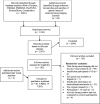Functional neuroimaging of visual creativity: a systematic review and meta-analysis
- PMID: 27781148
- PMCID: PMC5064346
- DOI: 10.1002/brb3.540
Functional neuroimaging of visual creativity: a systematic review and meta-analysis
Abstract
Introduction: The generation of creative visual imagery contributes to technological and scientific innovation and production of visual art. The underlying cognitive and neural processes are, however, poorly understood.
Methods: This review synthesizes functional neuroimaging studies of visual creativity. Seven functional magnetic resonance imaging (fMRI) and 19 electroencephalography (EEG) studies were included, comprising 27 experiments and around 800 participants.
Results: Activation likelihood estimation meta-analysis of the fMRI studies comparing visual creativity to non-rest control tasks yielded significant clusters in thalamus, left fusiform gyrus, and right middle and inferior frontal gyri. The EEG studies revealed a tendency for decreased alpha power during visual creativity compared to baseline, but comparisons of visual creativity to non-rest control tasks revealed inconsistent findings.
Conclusions: The findings are consistent with suggested contributions to visual creativity of prefrontally mediated inhibition, evaluation, and working memory, as well as visual imagery processes. Findings are discussed in relation to prominent theories of the neural basis of creativity.
Keywords: creative cognition; creative ideation; electroencephalography; functional magnetic resonance imaging; idea generation; ideation; visual creativity; visual design; visual imagery.
Figures




References
-
- Abraham, A. , & Windmann, S. (2007). Creative cognition: The diverse operations and the prospect of applying a cognitive neuroscience perspective. Methods, 42(1), 38–48. - PubMed
-
- Amabile, T. M. (1983). The social psychology of creativity: A componential conceptualization. Journal of Personality and Social Psychology, 45, 357–376.
Publication types
MeSH terms
LinkOut - more resources
Full Text Sources
Other Literature Sources

